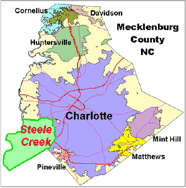|
ABOUT STEELE CREEK A great place to live, work, and play!
The Steele Creek Community is one with long heritage and history in formation of our county and state. Most likely, Scotch-Irish immigrants who came through Philadelphia and followed the wagon roads south to a more temperate climate founded the community in the late 1600's and early 1700's. Settlers found virgin forestland inhabited by a large variety of wildlife. Steele Creek, the small stream from which the community gets its name, rises from a spring on property near the intersection of Steele Creek Road and Shopton Road and flows south and east into South Carolina. Some historians attribute the name "Steele" to a family living near the headwaters of the creek in early settlements. However, no family with that name can be confirmed as living in the area. We can trace land grants made by the King of England in 1751 to the Neely, McDowell, and Whiteside families living in Steele Creek. Families with these names still live in the community. With the strong Scotch influence, Presbyterian Churches began to dot the countryside. Steele Creek Presbyterian, founded in 1760 on Steele Creek Road, was one of the historical first seven churches in the county. Steele Creek provided two signers of the Mecklenburg Declaration of Independence on May 20, 1775, a document that preceded by more than one year the Declaration that we celebrate on July 4 each year. Duke Power 's predecessor, the Catawba Power Company, built the Catawba Hydroelectric Station and its 668 acre lake in 1904. This was the first generating station in the Duke system. The "New Catawba" hydro station replaced this facility at the same location in 1925. In 1960 the station and the lake it impounded was renamed after W. Gill Wylie, one of the company's founders. These facilities have created electrical power and later, recreational opportunities for thousands. Lake Wylie is the lowest in the chain of lakes along the Catawba River in western Mecklenburg County. It has 325 miles of shoreline and 13,443 acres of surface water. In
1940, the U.S. Government bought 2266 acres in Steele Creek to build
an ammunition assembly plant. It employed over 12,000 people at
one time. Renamed in 1946 to the U.S. Naval Ammunition Depot, the
depot was phased out in 1951 and later auctioned to private industry.
The area became known as "Arrowood," named for the dairy
that bordered on one side. Most residential and commercial development continues to be concentrated along the S Tryon Street corridor, but several large new residential communities are being developed in the western fringes of Steele Creek. As the area has matured, more housing and retail choices are becoming available. Upper Steele Creek is home to the new Berewick neighborhood and the mixed-use Ayrsley development. Businesses in the Whitehall area along S Tryon Street offer residents a variety of choices for shopping and dining. In Lower Steele Creek, the intersection of Highways 49 and 160 (S Tryon Street and Steele Creek Road) has seen major new development and is considered by many residents as their "Town Center." New stores continue to open in the RiverGate Center. The new Palisades and Sanctuary developments continue to receive recognition for their environmental sensitivity. |



